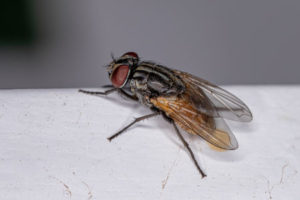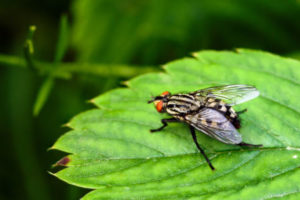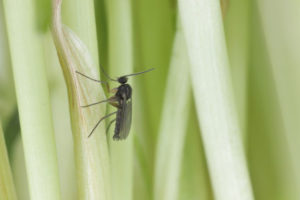Why do I have flies every summer?
By Zachary Ciras on July 21, 2022.
A fly buzzing around your home is often a nuisance unparalleled by almost any other annoyance. While the kids may enjoying fluttering around the house with swatter in hand, the novelty usually tires before the flies do. And when the family is resting, but the stridulation from our two winged nemesis persists, one three-lettered word won’t retire until it is answered: WHY!?
Filth Flies

Adult House Fly of the species Musca domestica
The presence of flies may indicate a number of various things, but commonly, flies are feeding on decaying organic matter. The group of flies associated with these types of sources are commonly known as Filth Flies. An example of a fly that is not a filth fly would be Cluster Flies, which are parasitic to earthworms and are overwintering pests inside structures. Falling autumnal temperatures are the key factor for cluster fly infestations inside structures. (See: Plan Now to Control Cluster Fly Intruders Next Fall ) What folks see in the summer are not typically these type. Filth flies have a source, though it may not be inside the house, of decaying organic matter. Animal matter or vegetable matter are both food and breeding sites for these flies.
Flies are classified as Diptera, meaning “two wings”, as flies have only one pair of wings as opposed to ants, termites, wasps, etc., which have two pairs each on their alates. They undergo a complete life cycle of egg, larvae, pupae, adult. The larval stage, or maggots, are the primary feeders on the decaying organic matter. Adult flies lay their eggs on the food source, where the larvae feeds then crawls away to pupate. After some time, the adult fly emerges from the pupal casing, just like a butterfly emerges from its chrysalis. See What Do Fly Maggots Look Like?
Green Bottle Flies and House Flies
The common green bottle fly may easily be confused with a common housefly. House flies and green bottle flies are both about 1/4″ long with read eyes and transparent wings, but the housefly has four dark stripes along its thorax and a muted checker pattern on its abdomen. The green bottle fly is completely metallic green in color, though the shading and vibrance may vary. Both are active flyers during the day. They are attracted to light and windows, and they will rest on walls, floors, and countertops. The adults can live up to three weeks and are attracted to a variety of feeding materials. Decaying Organic Matter such as garbage and open food often draws these flies to feed. The green bottle fly is most associated with decaying organic vegetable matter and animal excrement. This could be the dog mess in the back yard, decomposing grass clippings, vegetation in the woods, or neglected garden vegetables for example. The individual adults can be rather annoying and may show up in small to moderate sized groups. it’s not uncommon to see anywhere from 1-15 flies in a house at a time in the summer. More may present themselves on plants outside of your home as well. It’s not uncommon to find dozens of house and green bottle flies on bushes along a home, especially holly bushes and other plants with scale insects or aphids. The bushes themselves pollenate, and in the case of holly the pollination occurs in the lat summer, and this alone may contribute to flies, seeking out the flowers and nectar. Once the scale insects and aphids feed on the plants, too, they excrete a sweet byproduct called honeydew. Flies, not to mention ants, absolutely love this sweet sugary food, and will swarm to it to feed. They then wander inside your home and become a nuisance.
Blue Bottle Flies
Blue Bottle Flies on the other hand are most associated with decaying organic animal matter. When our technicians identify the fly species in a home as blue bottle flies, their inspection turns from looking for garbage to mice. The numbers for blue bottle flies are often more impressive, as the host from which the flies are emerging is located inside the house. We often get complaint calls for large, slow moving flies in great numbers, but the numbers dwindle down in mere days. After a proper identification, our technician inspects for the source of the flies. For Blue Bottle Flies, mice are a typical cause, as the expired mouse carrion is attractive to this type of fly. Green bottle flies will also consume decaying organic animal matter and blue bottle flies will feed on vegetation, but the Blue Bottle is very closely correlated to a mouse infestation. By the time a homeowner experiences the fly infestation, the mouse host has already been exhausted. The flies are the symptom of the other issue, and both should be addressed.
Flesh Flies

Flesh fly close up
Another fly linked to residential rodent infestations is the Flesh Fly. The common name of the Sarcophagidae family of flies is about as descriptive as an entomologist could summon! One key differentiator to other filth flies is that Flesh Flies will deposit the larval stage rather than the egg onto its host material, whether it is carrion, dung, or open wounds. Flesh flies are one of the fly species routinely found around farms with livestock. Farm animals with wounds are easy targets for depositing fly larvae. Identifying flesh flies is also fairly striking, from their red eyes, to their gray and black stripes on the thorax, to the distinct checkered pattern on the abdomen. Homes with a rodent infestation near farmland are most vulnerable to flesh fly infestations.
Small Flies
Not all summer flies are these large filth flies, though these are often the cause of the most annoyance, and which one can do the least about. Small flies are also pests in the heat, but many of these have sources inside or very near the structure where the homeowner has more control.
Fruit Flies
Red Eyed Fruit Flies are not in search of excessively decayed matter, but rather for the thin vinegar layer found on ripe to over-ripe fruit. Also known as vinegar flies, these fruit flies can emerge quickly from produce you brought home from the store. The fly species to which fruit flies belong is Drosphilia, which means “lover of dew,” suggesting a moist environment is preferred for breeding. Bananas are a common culprit. Using bananas as an example, fruit fly eggs, which are very small and difficult to see with the human eye, are deposited on the surface of the fruit. Ripe fruit has some level of fermentation occurring on the surface, and that’s what the flies are drawn to. The larvae emerge within one or two days after the deposit, and within five or six days, the egg to pupae transition has been completed. Adults emerge and become sexually capable within two days, with females capable of depositing an average of 500 eggs in their 40-50 day lifespan. Fruit flies are very attracted to light. The life cycle of fruit flies happens so quickly that the numbers can seem overwhelming in a short period of time. Finding the breeding source(s) is the most critical point to control. For more on fruit flies entering the house from outside fruit and veg., see Fall Fruit Fly Problems.
Black Flies
Some small flies are less under our influence, such as Black Flies, or biting gnats. Black flies are prevalent in New Hampshire especially. They breed in clean, flowing water, such as rivers and streams, and can be a terrible nuisance and pain point for folks who live in these areas. Light traps, repellents, and mechanical exclusion such as screening in porches and maintaining proper screening at windows are some control methods to protect yourself from painful bites. Because the flies are coming from the river, chemical measures to control the population is not likely to be used by structural pest control companies. Systemic larvicides has shown some promise for relief, but large scale cooperation is required to even attempt this level of mitigation.
Fungus Gnats

adult of Dark-winged fungus gnat, Sciaridae on the soil. These are common pests that damage plant roots
Fungus gnats are often misidentified as fruit flies in homes and workplace settings. Without a very close inspection, that confusion could be understood. Small dark flies in a home are often assumed to be coming from or looking for foodstuff, but fungus gnats are not interested in that fermenting vinegar layer on decaying organic matter. As their colloquial name suggests, these small flies are in search of fungus to breed and feed. Houseplants form fungal growth when they are watered to excess, and fungus gnats are attract to this. You may see small clumps of white fungus mixed in to the top layer of soil. Fungus gnats lay their eggs near this and grow within the soil and then emerge as flies. Fungus gnats may also breed outside of the home, especially in overwatered soil and mulch. Shady, moist spots around the home will breed these flies. If these breeding sites are near enough the home, the tiny fungus gnats may enter through windows, doors, and gaps around the house. Once inside, these flies will take advantage of fungal growth and multiply.
Identification and solutions
As with most pest problems, proper identification of your pest is the first and crucial step to finding a solution. Our trained professional technicians will find, identify, and propose solutions to your summer fly problems. In some cases, environmental measures can be taken to reduce your exposure to the flies. In other cases, chemical application may be needed. These are just a small list of the flying insect you see over the warm months. Whatever the case an understanding of the various sources, biology, and behavior of these flying pests will inform the action needed to get some respite. After all, FLY CONTROL HAS COME A LONG WAY SINCE 1917! Give us a call and we can identify and plan for corrective actions and prevention to keep your busy home buzz free.